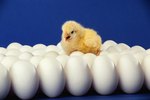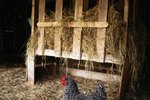
If you own hens, you may wonder how long your layers will live and continue to lay. Much depends on the care your chicken receives as well as hereditary factors. However, lifespan doesn't equal egg laying and old chickens lay infrequently, if at all.
Lifespan
According to the Montana State University Extension, no one knows a laying hen's lifespan. Commercial egg producers cull layers (called battery hens) when they're one to three years old. Meat birds are slaughtered at six to eight weeks. Backyard flocks see hens living more than five years, with a few living to eight or more years. The oldest recorded hen lived to a ripe old age of 16.
Considerations
How old a layer will live depends on care. Hens fed a balanced diet will live longer than one that is malnourished. Proper parasite management, internal and external, can keep your hens healthy. Good biosecurity measures will help keep lethal diseases from spreading to your flock. Lastly, keeping your flock safe from predators, such as raccoons, skunks, and weasels, will prevent your birds from suffering an untimely demise.
Laying Lifespan
Your hen may live a long time, but she may not lay the entire time. By the time your hen reaches three years old, her egg output has dropped to 65 percent of her maximum laying ability. This declines rapidly to where if your hen lives to 10 years old, she will only lay 20 percent of the maximum egg output of her first year. Matilda, the hen that lived to 16 years old, did not lay eggs.
Bantam Hens
Chickens come in two sizes: large fowl, and the smaller bantam. Bantam hens live between four and eight years, and grow to about one-third the size of "regular" or large fowl.
References
- Montana State University Extension: How Long do Chickens Live?
- Poultrykeeper.com: How Long do Chickens Live?
- UKAg: Frequently Asked Poultry Questions
- University of Florida IFAS Extension: Factors Affecting Egg Production in Backyard Chicken Flocks
- Mypetchicken.com: How Long do Chickens Live?
- Countryfarm Lifestyles: Bantam Chickens, Breeds, Diseases, and How to Care for your Bantams
- USDA: Biosecurity
Photo Credits
-
Thinkstock Images/Comstock/Getty Images




